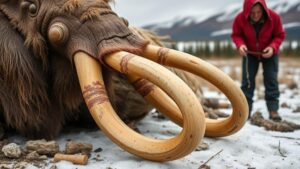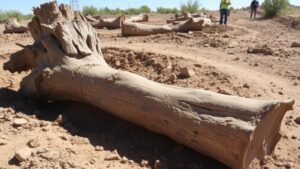Searching for fossilized fern impressions in the coal-rich regions of Pennsylvania.
Searching for Fossilized Fern Impressions in the Coal-Rich Regions of Pennsylvania
Pennsylvania is renowned for its coal deposits, which date back to the Carboniferous period (approximately 359 to 299 million years ago). Among the myriad of geological treasures found in this area, fossilized fern impressions stand out, captivating the attention of rockhounds and mineral collectors alike. The allure of discovering these ancient plants, which once flourished in lush, swampy environments, adds a layer of excitement and educational value to any fossil hunting expedition.
The Significance of Fossilized Ferns
Fossilized fern impressions provide an invaluable window into Earth’s history. e fossils not only allow us to understand the biodiversity of the past but also inform us about the climatic conditions and the ecosystems that existed millions of years ago. In Pennsylvania, the fossil record indicates that ferns were dominant in forest ecosystems, thriving in the humid climate of the Carboniferous period. The famous “coal forests” were home to plants such as Lepidodendron and Sigillaria, but ferns were a prevalent species, contributing significantly to the fossil record.
Where to Search in Pennsylvania
Several regions in Pennsylvania are particularly rich in coal seams and fossilized fern impressions. Key locations include:
- The Anthracite Coal Region: Encompassing areas like Schuylkill and Luzerne Counties, this region is known for its high-quality anthracite coal and a diverse collection of fossils.
- The Bituminous Coal Region: From the Pittsburgh Basin to the Allegheny National Forest, this area features a variety of fossil sites, including impressive fern imprints.
- Local Quarries and Road Cuttings: Many collectors find success in visiting old quarries or road cuts where sedimentary layers are exposed, revealing fossil beds.
Understanding Fossilization
The process of fossilization can take thousands to millions of years, involving several stages such as burial, mineralization, and imprint formation. The most common type of fossils found among ferns are impressions, which preserve the shape and texture of the leaves without retaining organic material. This occurs when ferns, buried under sediment, leave an imprint in the mud or silt, which eventually hardens into rock.
Collecting fossilized fern impressions typically involves identifying these key features:
- Leaf Shape: Look for frond-like structures which may exhibit intricate vein patterns.
- Texture: Impressions may vary in texture; some are smooth while others show detailed vein outlines.
Tips for Collecting Fossilized Fern Impressions
For rockhounds eager to delve into fossil collecting, here are several practical tips:
- Research Before You Go: Familiarize yourself with local geology and fossil types. Resources such as geological surveys or local rockhound clubs can be incredibly informative.
- Use Proper Tools: Bring tools like hammers, chisels, and safety goggles. A hand lens can also be useful for examining fine details on your finds.
- Respect the Environment: Follow local regulations, avoid damaging sites, and practice sustainable collecting.
- Take Photos: Document your findings in situ, noting the location and conditions which can aid in later identification.
Real-World Applications and Community Engagement
Collecting fossils has broader implications beyond personal interests. Fossils play critical roles in education, providing tangible links to Earths history for students and enthusiasts. Local museums often feature fossil collections and may offer workshops for amateur paleontologists or rockhounds.
Also, sharing your finds with the community through local clubs can foster connections among collectors, enhancing knowledge sharing and conservation efforts. Organizations such as the Pennsylvania Geological Survey and the Maryland Geological Society often host field trips and workshops focused on fossil identification and preservation.
Conclusion: The Joys of Collecting Fossilized Ferns
Searching for fossilized fern impressions in Pennsylvania can be a deeply rewarding pursuit for rockhounds and mineral collectors. Not only does it connect individuals with natural history, but it also promotes environmental respect and community involvement. As you venture into this vibrant region, remember to explore responsibly, enjoy the thrill of discovery, and preserve these ancient relics for future generations.



